Will there be declines in gold prices coming?
On Wednesday, gold steadied above $2,060 an ounce after a drop in the previous session.
Investors are waiting for the minutes of the latest Federal Reserve meeting for clues on what monetary policy will be in the future.
On Tuesday, the metal fell from intraday highs and closed down 0.2 percent. This was caused by a rebound in the dollar and Treasury yields.
Market participants downgraded their expectations about the possibility of interest rate cuts by major central banks this year.
Currently, there is a 70 percent probability that the U.S. central bank will make a quarter-point cut in March, up from the previous 90 percent.
After adopting a neutral stance on gold in early November, I began to pay more attention to the downside when the metal failed to consolidate gains above the $2,000 mark.
In fundamental terms, although the decline in real bond yields in recent months has created a favorable environment for gold, it still remains well above the levels associated with current real yields.
Overall, risks are strongly tilted toward a further decline in gold prices in the coming months.
Gold's chart pattern is extremely bearish after failing to maintain levels above $2,000.
This false break is similar to the one observed in March 2022, which led to a 22 percent loss in the metal's value over the next 6 months.
Currently, there is no significant support until the price falls to the $1,800 area, which corresponds to the October lows.
The recent lack of gains above $2,000 is worrisome, especially considering that the futures and options markets show a positive stance for further increases.
In fact, net non-trade positioning is at its most bullish level since April 2022, after rising sharply from the October lows.
This could be seen as a contrarian signal to experienced investors.
In a bearish technical environment, there is reason to be concerned about gold given that fundamentals point to a lower value than the current one.

This estimate comes from the correlation between gold and 10-year inflation-indexed U.S. bond yields and between the gold-to-industrial-metal ratio and 10-year nominal bond yields.
Although bond yields have declined in recent months, long-term inflation expectations and industrial metal prices are also declining.
As a result, the fair value of gold has improved slightly but still remains significantly below its current value.
It is theoretically possible that the fundamental situation will improve dramatically as the Fed cuts rates.
However, the difficult fiscal situation in the United States strongly suggests a return to negative 10-year real yields, as the current positive 2 percent is unsustainable.
This could mean very good news for gold, but markets are already anticipating aggressive rate cuts for 2024 and beyond.
This indicates that any improvement in economic data or a rise in inflation could cause a slowdown in falling yields, severely hampering gold prices.
According to my forecast, gold prices will reach $1,800 in the next quarter.
On Wednesday, gold steadied above $2,060 an ounce after a drop in the previous session.
Investors are waiting for the minutes of the latest Federal Reserve meeting for clues on what monetary policy will be in the future.
On Tuesday, the metal fell from intraday highs and closed down 0.2 percent. This was caused by a rebound in the dollar and Treasury yields.
Market participants downgraded their expectations about the possibility of interest rate cuts by major central banks this year.
Currently, there is a 70 percent probability that the U.S. central bank will make a quarter-point cut in March, up from the previous 90 percent.
After adopting a neutral stance on gold in early November, I began to pay more attention to the downside when the metal failed to consolidate gains above the $2,000 mark.
In fundamental terms, although the decline in real bond yields in recent months has created a favorable environment for gold, it still remains well above the levels associated with current real yields.
Overall, risks are strongly tilted toward a further decline in gold prices in the coming months.
Gold's chart pattern is extremely bearish after failing to maintain levels above $2,000.
This false break is similar to the one observed in March 2022, which led to a 22 percent loss in the metal's value over the next 6 months.
Currently, there is no significant support until the price falls to the $1,800 area, which corresponds to the October lows.
The recent lack of gains above $2,000 is worrisome, especially considering that the futures and options markets show a positive stance for further increases.
In fact, net non-trade positioning is at its most bullish level since April 2022, after rising sharply from the October lows.
This could be seen as a contrarian signal to experienced investors.
In a bearish technical environment, there is reason to be concerned about gold given that fundamentals point to a lower value than the current one.

This estimate comes from the correlation between gold and 10-year inflation-indexed U.S. bond yields and between the gold-to-industrial-metal ratio and 10-year nominal bond yields.
Although bond yields have declined in recent months, long-term inflation expectations and industrial metal prices are also declining.
As a result, the fair value of gold has improved slightly but still remains significantly below its current value.
It is theoretically possible that the fundamental situation will improve dramatically as the Fed cuts rates.
However, the difficult fiscal situation in the United States strongly suggests a return to negative 10-year real yields, as the current positive 2 percent is unsustainable.
This could mean very good news for gold, but markets are already anticipating aggressive rate cuts for 2024 and beyond.
This indicates that any improvement in economic data or a rise in inflation could cause a slowdown in falling yields, severely hampering gold prices.
According to my forecast, gold prices will reach $1,800 in the next quarter.
